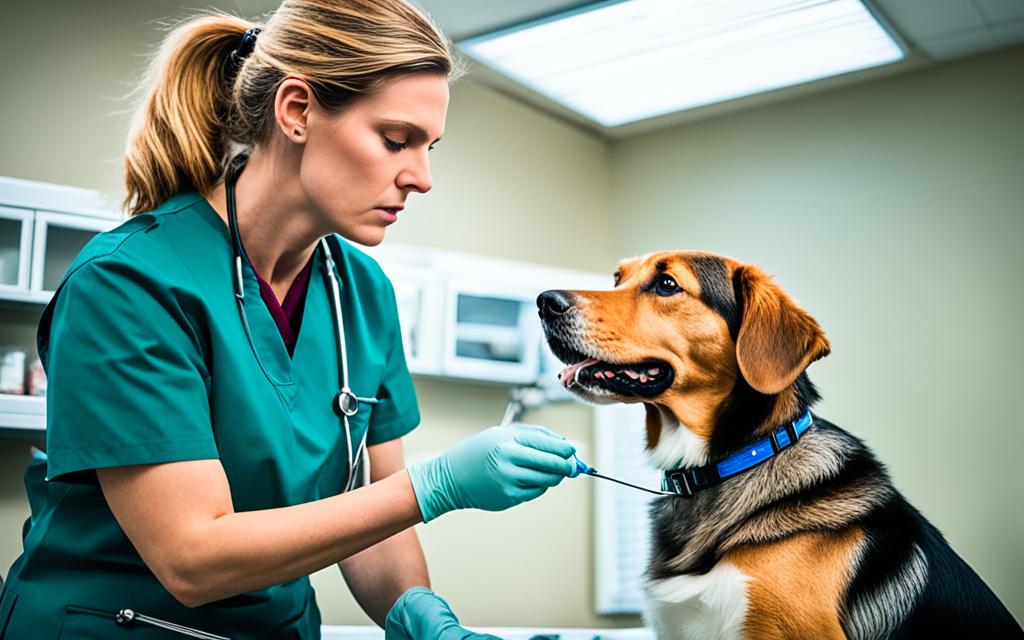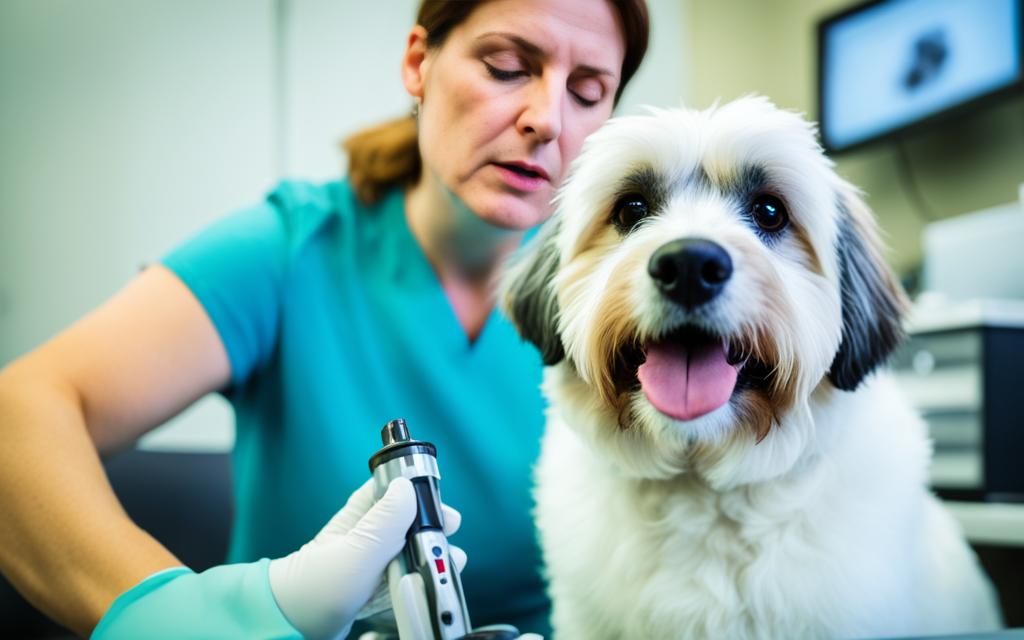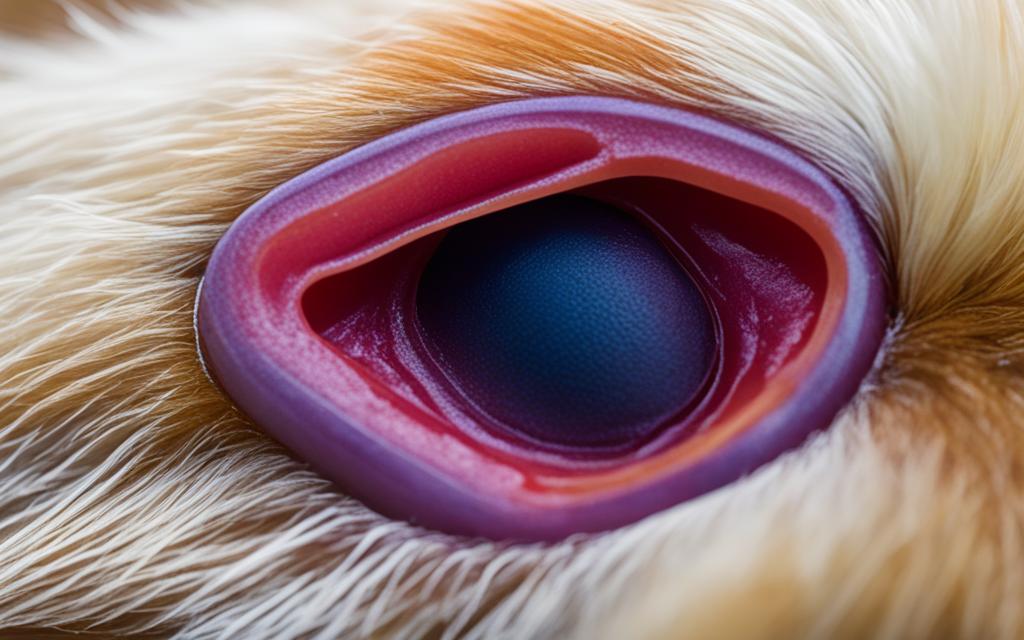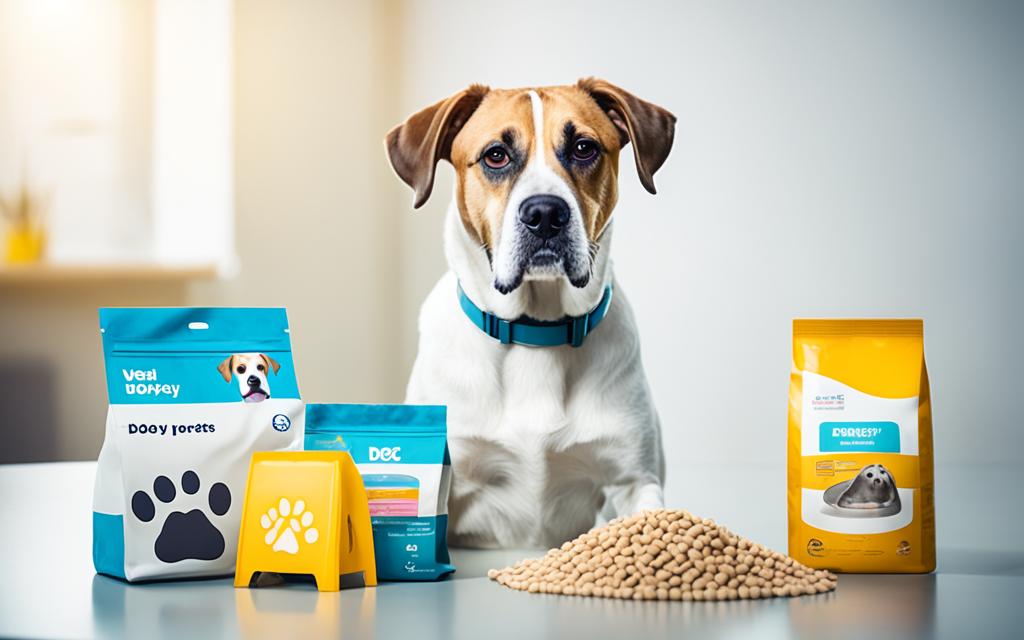Canine cancer is a serious issue that can hit dogs of all breeds and ages. It’s vital to spot the early signs of dog cancer to keep your furry friend healthy. By knowing what to look for, you can boost the chances of successful treatment through early detection. Being alert and well-informed is crucial for spotting canine cancer and taking the right steps. With the right knowledge and proactive actions, dog owners can protect their pets’ health and happiness.
Understanding Canine Cancer
Canine cancer means a group of diseases where cells grow too much in dogs. It comes from genes and the environment. Knowing how it starts helps spot signs early.
Canine cancer includes many types of tumors, which can be benign or malignant. Benign ones grow slowly and don’t spread. Malignant ones can spread and cause serious health problems. The type of tumor and its behavior depend on the dog’s age and breed.
Older dogs face a higher risk of getting cancer. Many cancers become more common as dogs age. Knowing this helps pet owners prevent it and keep their dogs healthy.
| Type of Cancer | Characteristics | Common Breeds Affected |
|---|---|---|
| Lymphoma | Common type, affects lymphatic system, aggressive. | Golden Retrievers, Boxers |
| Osteosarcoma | Malignant bone tumor, painful, common in large breeds. | Great Danes, Rottweilers |
| Hemangiosarcoma | Affects blood vessels, aggressive, often undetected until advanced. | German Shepherds, Border Collies |
Importance of Early Detection
Finding cancer early in dogs is key to better health for your pet. When caught early, there are more treatment options. Early detection can greatly extend a dog’s life. Dogs diagnosed early often live longer than those found out later.
It’s important for dog owners to stay aware of their pet’s health. Regular vet visits and watching for behavior changes help catch cancer early. Vets suggest screenings for dogs at risk of certain cancers. This helps owners act fast if something goes wrong.
Waiting too long to diagnose cancer can be very risky. It makes treatments less effective and lowers survival chances. Regular vet visits and talking with vets help owners catch problems early. This is good for their pets’ health and life span.
Common Signs of Canine Cancer and Early Detection
Spotting cancer signs early in your pet can change their health story. Many signs may hint at serious health problems. Knowing these symptoms helps you act fast, which can improve your pet’s health outlook.
Unexplained Weight Loss
Unexplained weight loss is a big red flag for canine cancer. This can happen slowly, so it’s easy to miss. A big weight drop might mean lymphoma or other cancers, like those in the digestive tract. Watching your pet’s weight closely can catch this early.
Changes in Appetite
Changes in eating habits could mean health problems. If your dog eats less or won’t eat at all, it’s serious. Not eating can also mean other cancer signs are showing up. Keep an eye on how much your pet eats to spot any changes.
Behavioral Changes
Behavior changes can hint at health issues, like cancer. If your dog seems tired, pulls away, or doesn’t want to play, it could be a sign. Watching how your pet acts normally helps you notice these changes fast.

| Symptoms | Description | Possible Implications |
|---|---|---|
| Unexplained Weight Loss | Significant decrease without changes in diet or exercise. | May indicate serious illness including cancer. |
| Changes in Appetite | Reduced interest in food or sudden refusal to eat. | Potential sign of underlying health conditions. |
| Behavioral Changes | Increased lethargy or withdrawal from usual activities. | May signify a serious medical concern. |
Common Types of Canine Cancer
Dogs can get many types of cancer, and it’s important for owners to know about them. Each type has its own symptoms and risks based on the dog’s age. This knowledge helps in catching cancer early and treating it quickly. Let’s look at some common cancers in dogs, like lymphoma, osteosarcoma, and hemangiosarcoma.
Lymphoma
Lymphoma is a common cancer in dogs, mainly found in those in their middle years. It starts in the lymphatic system, which helps fight off infections. Dogs with lymphoma may have swollen lymph nodes, lose weight, feel tired, and eat less.
Osteosarcoma
Osteosarcoma mostly affects big breed dogs and causes a lot of pain and swelling. Dogs with this cancer may limp, not want to move, and have swelling over their bones. It’s a fast-growing bone cancer that needs quick vet care.
Hemangiosarcoma
Hemangiosarcoma is a very aggressive cancer that attacks blood vessels. It’s hard to spot early on, making it tricky to catch. There are different types, like splenic and cardiac, which can cause sudden bleeding inside the body. Early signs might be feeling very tired and bruising easily.
| Canine Cancer Type | Common Symptoms | Age Group | Breed Susceptibility |
|---|---|---|---|
| Lymphoma | Swollen lymph nodes, weight loss, lethargy | Middle-aged | Any breed |
| Osteosarcoma | Pain, swelling, limping | Young to middle-aged | Larger breeds |
| Hemangiosarcoma | Lethargy, bruising, weakness | Older dogs | Any breed |
How to Recognize Symptoms at Home
Being a keen pet owner helps you spot health issues in your dog. It’s important to watch for changes in how they act or look. Keeping track of your dog’s health is key to catching problems early.
Daily Observation Tips
Watching your dog every day is key to spotting illness signs. Here are some tips:
- Activity levels: Look for changes in how much energy they have, like being too tired or too active.
- Grooming habits: Notice if they don’t want to groom or do it less often, which could mean they’re not feeling well.
- Eating and drinking: Check if they’re eating or drinking differently, like eating more or less, which could be a sign.
- Bathroom habits: Make sure their bathroom habits are normal, as changes could mean health problems.
- Social behavior: Watch how they act with family and other pets for any mood or behavior changes.
Maintaining a Health Journal
Keeping a health journal for your dog is helpful. It lets you track their daily habits and share important info with your vet. A good journal should have:
- Date and time of observations
- Details of any unusual behaviors or symptoms
- Notes on meals, including any changes in diet or preferences
- Regular weigh-ins to track weight changes
- Environment changes or stressors, like new pets or changes in routine
When to Consult a Veterinarian
Knowing the signs you need veterinary care is key to your dog’s health. Some conditions need quick action, especially if there’s a chance of cancer. Watch for big changes in how your dog acts, eats, or looks.
If your dog suddenly loses weight, keeps vomiting, or seems very tired, get vet help fast. When to visit the vet often depends on these signs. Also, look out for hard breathing, swelling, or not wanting to do fun activities.
Here is a quick reference table of scenarios that require urgent veterinary attention:
| Condition | Signs | Action |
|---|---|---|
| Weight Loss | More than 10% over a month | Visit the vet promptly |
| Vomiting | Repeated episodes over 24 hours | Consult a veterinarian immediately |
| Lethargy | Unresponsive, less active than usual | Schedule an urgent appointment |
| Swollen Abdomen | Visible distension, pain when touched | Seek help right away |
| Difficult Breathing | Labored breathing, excessive panting | Emergency vet visit required |
Quick action is crucial for your dog’s life. Knowing when to visit the vet helps owners act fast. This can lead to better health for your pets.

Diagnostic Procedures for Canine Cancer
Diagnosing canine cancer involves detailed procedures. These steps help vets understand health concerns about your dog. Knowing how these procedures work can ease the process for you and your pet.
Blood Tests and Biopsies
Dog blood tests are key in spotting cancer. They check the blood for signs of cancer cells. Biopsies then give clear results by looking at tissue samples under a microscope. Together, these tests help vets confirm cancer and plan treatments.
X-rays and Ultrasounds
Imaging tools like X-rays and ultrasounds are vital for seeing inside your dog. X-rays check bones and can spot tumors. Ultrasounds show soft tissues and organs, helping to see conditions X-rays can’t. These tools help vets understand your dog’s health and diagnose cancer accurately.
Treatment Options for Canine Cancer
When dogs get a cancer diagnosis, it’s key to know the treatment options. This part looks at different treatments for dog cancer. Each one is made for certain types of cancer and their stages.
Surgery
Surgery is a main way to treat tumors. Vets aim to remove tumors fully to stop them from spreading. How well surgery works depends on the cancer type and stage. If caught early, surgery might help your dog fully recover.
Chemotherapy
Chemotherapy uses drugs to kill cancer cells that have spread. It can make tumors smaller, help your dog live longer, and improve their life quality. The treatment plan depends on the cancer type and your dog’s health.
Radiation Therapy
Radiation is used for tumors hard to remove with surgery. It can shrink tumors, ease pain, or help with comfort in late stages. Talking to a vet specialist can show if it’s right for your dog.
Supportive Care for Ailing Dogs
Supportive care is key for dogs with cancer. It goes hand in hand with treatments like chemotherapy and surgery. Adding comfort measures can make their life better. This means using pain meds or other holistic ways to help them feel better.
Creating a caring space helps your dog’s feelings. Things like a comfy spot to rest, a peaceful place, and quality time with you are important. Doing gentle activities together, like short walks or massages, can also make them feel better and bring you closer.
When dealing with canine cancer, it’s about caring for both their body and heart. By focusing on supportive care, you make sure they feel loved and secure. This helps them go through tough times with grace and strength.




